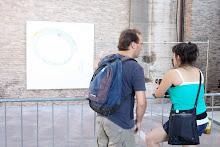
*A review of Roman History with Mr. Sullivan, the first of 3 weekend seminar classes.
The saying, “go and wake up your luck”, was the first thing that I thought when I awoke that morning. If I was a man who believed in luck that is, it would appear that mine had decided to sleep in that morning. Now, don’t take my disbelief towards the cosmic gods of fate as a sign of my inner cynic, but merely the misguided ramblings of a guy running late for class. The day was Saturday February 13th, the first day of my weekend Rome seminar classes, and I somehow managed to oversleep.
Arriving 40 minutes later but no worse for wear, I enter Sacramento high school and began to brace myself for the monumental task that lay ahead of me. Our agenda for the day was to cover the entire history of Rome in less than 3 hours.
Our instructor for the day was Mr. Sullivan, one of the most down to earth Martians you could ever meet. His goal was to get all of us to absorb as much Roman history as possible without our heads exploding. This was so we could appreciate all the wonders of Rome more fully if we ever got the chance to go.
The first thing that stuck out to me was the history of Spartacus and slavery. The story of Spartacus follows a slave leader (Spartacus) starting an uprising against the Roman Republic. I find this piece of history incredibly engrossing because of how these events mirror those in American history so closely. These similarities were that the system of slavery wasn’t based on color but on contracts akin to the system of indentured servitude. Another similarity that I found interesting was the causes behind the revolts and their end results. Both revolts are seen as a battle of the oppressed against that of their oppressors. It was this strong representation of social activism in human history that made it so remarkable to me.
Another thing I found intriguing during my quest through time was Rome’s hand in driving lions and leopards to the point of extinction in Europe. Before attending this seminar on Roman history I was aware that animals were used in the Coliseum's gladiator shows. However, I did not know to what how many animals were slaughtered for mere entertainment value. The reason I found this fact so jarring was that Americans repeated this same atrocity centuries later in the form of the buffalo.
In addition to being the leaders in slave uprisings and animal cruelty, I found Rome’s ability to recycle astounding. This green attitude of Rome’s was most apparent when I found out why there was such a huge chunk missing from the coliseum. Apparently, whenever Romans wanted to build something new, instead of traveling hundreds of miles to gather new stone,they just reused the stone that were just lying around collecting dust. This act of pragmatic thinking is so incredible to me because it shows Romans being one of the first cultures to practice recycling .
Finally, what I found most entertaining was the relevance Mr. Tom Hanks had in teaching Roman history. What I mean by this is not Tom Hanks the man but the character in which he embodies. The character Tom Hanks embodied for this particular example was Robert Langdon, a popular fictional character a series of books by Dan Brown. This was my highlight because of how often my instructor referenced Tom Hanks in order to get the point across to the class
Dennis Johnson

No comments:
Post a Comment